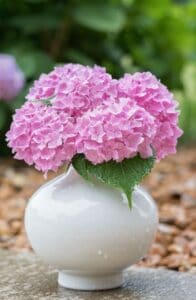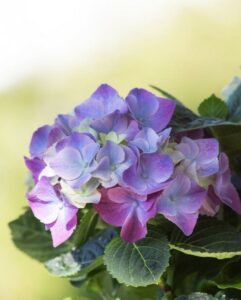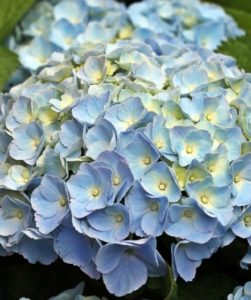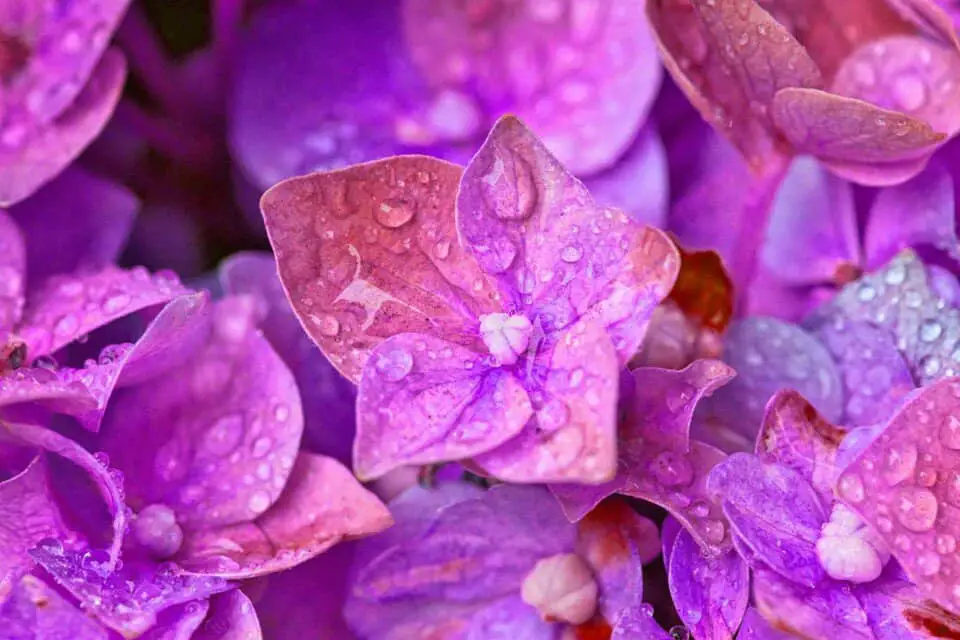Some links in the post are affiliate links and I get a commission from purchases made through some links found in the post.
Hydrangeas can survive frost and withstand a wide range of temperatures. Some types of hydrangea can withstand temperatures as low as -20 degrees Fahrenheit (-30 degrees Celsius).
In contrast, others, such as the well-known Bigleaf variety, are more susceptible to being damaged by frost.
You need to consider winter protection measures for your hydrangeas if you are growing a variety that is not cold resistant in your region. These precautions will reduce the likelihood of your hydrangeas being damaged by frost.
Hydrangeas that produce flowers from old wood require additional winter care to guarantee that the buds continue to develop.
It is thought that plants that blossom from fresh wood have a better level of frost tolerance, yet, even these plants are susceptible to late frost damage.
The hydrangea you have and its cold-hardy will determine how likely it is to make it through a wintry season.
Will Hydrangeas Survive Frost?
 Some types of hydrangeas can withstand temperatures as low as -20 degrees Fahrenheit (-30 degrees Celsius) at their roots.
Some types of hydrangeas can withstand temperatures as low as -20 degrees Fahrenheit (-30 degrees Celsius) at their roots.
However, this means that any damage caused by frost will most likely be superficial, and while it may prevent the plant from flowering the following year, it will not result in its demise.
However, this is not true for all varieties of hydrangeas. Freezing temperatures and bitterly cold winds throughout the winter can be fatal to certain types of hydrangeas because they cause the plant to dry up.
The stems and leaves of plants can lose their moisture content and become dehydrated when exposed to cold weather.
Hydrangeas that bloom on new wood can kill their new growth if there is a late frost in the early spring.
If it is sufficiently cold, the water contained within the plant’s cells may freeze, resulting in tissue damage that can ultimately lead to the death of parts of the plant.
How to Identify Damage?
On a hydrangea, discoloration is the most common evidence that it has been damaged by frost.
But there are many more signs to note around your plant: the foliage develops red accents, the buds get dry and form somewhat darker bodies, and parts of the plant begin to wilt.
The huge flowers of Hydrangea Macrophylla and other types of Hydrangeas, including Hydrangea Quercifolia, Hydrangea paniculata, and Hydrangea arborescens, can be a wonderful addition to a garden.
However, it is essential to have a working knowledge of how to care for your plants properly. Temperatures below zero can have a devastating impact on the appearance of your hydrangea.
You can assist your hydrangea in fully recovering from any damage caused by frost, as most of the harm will only be superficial.
It is highly improbable that a few nights with temperatures below zero will destroy the entire plant or cause major long-term damage.
Hydrangeas (H. Macrophylla and H. Quercifolia) that bloom on ancient wood can withstand temperatures of approximately -28 degrees Celsius in their root systems. New-wood bloomers are considerably more resistant to the bitter cold.
Newer, more benign growth on the plants, however, is susceptible to being damaged by cold. Because the air temperature is low enough to freeze the water contained within the plant cells, the new growth of hydrangeas is harmed.
When the water within the cells freezes and expands, it causes damage to the cell walls and ultimately results in the death of some of the plant’s components.
New growth is still young and tender and is more prone to damage in this way. The bad news is that the frost has most likely harmed your hydrangea.
If you have recently experienced some exceptionally cold weather and you see that your plant is changing a hue that you know is unnatural for this time of year or can hydrangeas survive frost.
How to Protect your Hydrangeas in Winter?

How well you care for your hydrangeas over the winter will impact the success and quantity of their blooms the following summer.
Protecting your hydrangea plant from the elements during the winter, whether planted in the ground or a container, begins well before the first frost of the season and continues until the final frost of the following spring.
Let’s look at the care that must be taken for your hydrangea during winter or whether hydrangeas can survive frost.
In-Ground Hydrangeas – Winter Protection
Create winter protection for your hydrangea planted in the ground by erecting a staked frame around the plant. Wrapping the stakes with chicken wire will allow you to build a cage out of the stakes.
To provide your plant with complete insulation, stuff the cage with pine needles and leaves. Oak leaves are useful for this purpose because, compared to other materials, they do not settle as easily.
It would be best to keep a bag of the leaves you raked up from your leaf pile in the fall to replenish the cage as the insulation settles throughout the winter.
Potted Hydrangeas – Winter Protection
Bringing potted hydrangea plants inside before the first frost is the simplest and most effective strategy to protect these plants from the cold weather that will persist throughout the winter.
If moving them would be too difficult, you can leave the pot and plant outside while protecting them by placing something over the whole thing.
Foam insulation is one approach you can employ to ensure the safety of your potted plants.
How to Protect your Hydrangeas from Frost in Spring
Hydrangeas require slightly different maintenance throughout the spring than they do during the other seasons.
During the spring, you should focus on coaxing your hydrangeas into reblooming and fostering the growth of an abundance of flowers.
Every beautiful flower that blooms in the summer results from some toil and care put in during the spring. Moreover, this is correct, and it is especially true with hydrangeas.
To bring your hydrangeas back to life after the winter dormancy phase, there are a few important actions that you will need to take in the springtime if you reside in an area where the temperature can drop lower.
However, this will help you make the most of their blooms and replace any plants you may have lost at the beginning of the season.
Hydrangeas require slightly different maintenance in the spring than in the summer. During the spring, the primary focus is on arousing them from their dormant state brought on by the winter.
During the summer, the primary concerns are maintenance, disease prevention, and insect control. In the springtime, it is essential to maintain adequate watering of your gardens.
Because the temperature does not appear to be high enough for your plants to require consistent watering, this chore is frequently neglected.
At this crucial juncture in the growing season, you can provide your plants with a significant boost by watering them in the same manner as you would during the warm summer months.
Can you Rescue a Frost-Damaged Hydrangea?
 Hydrangeas have the potential to be among the most gorgeous and abundant blooms in your garden or landscape, provided you take care of them properly.
Hydrangeas have the potential to be among the most gorgeous and abundant blooms in your garden or landscape, provided you take care of them properly.
However, can hydrangeas survive frost, and frost and cold can cause damage to them rapidly and with little to no advance notice?
You are in luck since there are a few things you can do to assist in restoring your hydrangeas to the former magnificence they once possessed; if not this year, then certainly the year after that.
Damage to your hydrangea caused by cold and frost can almost always be repaired, even though it can be a significant setback.
Hydrangeas that have been harmed can be treated by waiting until the temperature has warmed up and then cutting back the growth that has been affected.
There is still a chance that your hydrangea will bloom this year, and it should return to its normal growing tendencies come spring.
Frost and cold can harm a hydrangea, but these plants are happily resistant to such conditions.
Hydrangeas damaged by frost have a good chance of regaining their previous appearance with tender loving care and proper pruning. However, this may affect the flowers that bloom this year.
How to Rescue a Frost-Damaged Hydrangea?
You are probably aware that the recent pleasant weather has been wonderful, and as a result, your plants are thriving.
Then, out of nowhere, a cold snap sends the temps back to freezing, and suddenly, your lovely flowers and bushes are fighting to stay alive even though they were doing fine before.
The foliage and blooms of a Hydrangea are both susceptible to damage if they are exposed to extremely cold weather. The cold will cause the leaves to turn red, brown, or even black and become broken and brittle.
And if the temperature decrease occurred late enough in the year for your hydrangeas to have already flowered, the blossoms will certainly wither and turn brown due to the temperature change.
Hydrangeas are susceptible to damage from frost and cold, but does it mean the end of the story? Can hydrangeas survive frost?
When will your lovely bushes return to their normal appearance? To your good fortune, the response will almost always be yes.
Final Thoughts
 In this post, we have told you about Can hydrangeas survive frost? Even if the extremely cold weather has caused damage to your hydrangeas, there is a good chance that they will recover.
In this post, we have told you about Can hydrangeas survive frost? Even if the extremely cold weather has caused damage to your hydrangeas, there is a good chance that they will recover.
These are hardy plants, and while it is possible that they will not rebloom this year, as long as you prune back the damage that has been done, you should begin to see their magnificent blossoms the following spring if you complete the necessary pruning.
If you want to protect your hydrangeas from damage caused by frost or cold in the fall, you can either cover them or put a thick layer of mulch on the ground around them.
Damage caused by the cold may not be fatal to your hydrangeas, but it will likely reduce the number of vibrant flowers produced by the plant this year. Therefore, preventing harm is always preferable to treating it after the fact.


